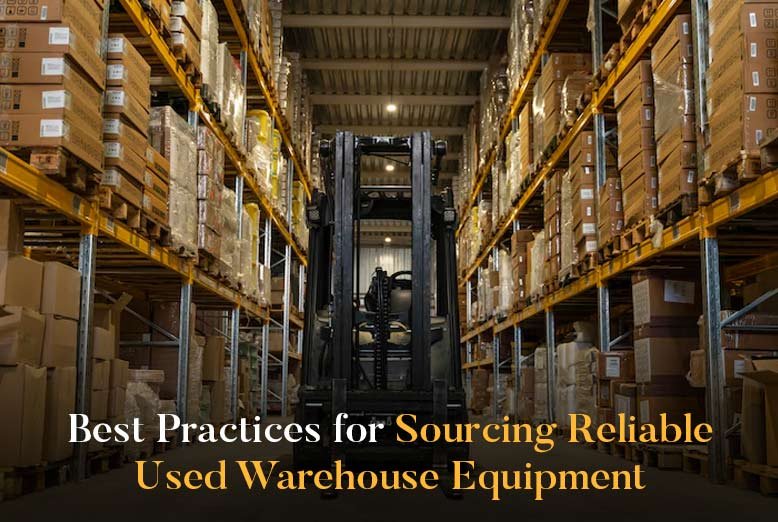Sometimes, buying brand-new warehouse equipment just isn’t realistic due to the cost factor. The budget doesn’t allow it, or maybe the need is temporary. Either way, used equipment becomes the apparent alternative. And honestly, in the proper context, it makes a lot of sense.
But here’s the thing—used doesn’t always mean dependable.
You’ve probably seen listings for forklifts, conveyors, or pallet racks online that seem too good to be true. That’s because they might be. The secondhand market is a mixed bag. Some sellers are professionals; others are just clearing out old stock. And then some know exactly what they’re doing—and hope you don’t.
That’s why used warehouse equipment should never be bought casually. It might work out. Or it might be a slow leak of problems that don’t show up right away.
Start With a Clear Checklist
Not everyone does this, but it’s worth sitting down and listing exactly what you’re looking for. Dimensions. Weight capacity. Electrical compatibility. Even minor things, like how often it’ll be used or whether you already have trained operators for that make or model.
You might think you’ll recognise the right unit when you see it. That can work sometimes. But guessing or going by memory opens the door to mismatches, especially when you’re on a time crunch and pressured to move fast.
Don’t Trust Photos Too Much
Everyone’s got a camera now. It’s easy to hide wear and tear behind clever angles. A lift truck with a dented mast might still look flawless from the right side.
That’s not to say all photos are misleading. But they’re controlled. Sellers decide what you see—and what you don’t.
Ask for a video walkaround. Better yet, ask for a recording that shows it in use. And if you’re local? Just see it. Even a 10-minute visit might tell you more than ten photos ever could.
Ask About Service History (Even If It Feels Awkward)
A machine’s past matters. Not in a dramatic way—but in an efficient one.
Was it maintained regularly? Or did it sit for months between servicing? These things don’t always show up right away. But once it’s on your floor and something breaks mid-shift, the lack of upkeep suddenly becomes very noticeable.
Some sellers will have detailed logs. Others might say, “It’s been working fine.” That might be true, or it might just mean no one bothered to check.
Don’t Just Look at the Price—Look at the Source
There’s a big difference between buying from a reseller that inspects equipment and a random listing on a classified site.
Sure, private sellers might offer better deals. But are they offering anything else? No warranty. No recourse if it dies in week two. And definitely no help installing it.
Sometimes it makes sense to take the risk. Other times, that 10% savings can turn into a series of expensive headaches. So, weigh that trade-off carefully.
Be Sceptical of the “As-Is” Label
A lot of sellers use this term. But it’s vague—and sometimes convenient.
“As-is” could just mean they’re not repainting it. Or it could mean something’s wrong and they’d rather not say what. Either way, you’ll want to know what, exactly, that phrase is covering.
Ask directly. Will they test it before shipment? Will they help load or deliver it? Is there a return policy? If they dodge questions, that should raise a flag.
Bring Someone With You—Even If You Think You Don’t Need To
A second pair of eyes helps. And ideally, that person knows how the equipment works. Could be a technician, a safety lead, or someone who’s dealt with similar gear before.
One person might overlook a loose chain or a hairline crack. Two people? Less likely.
And if the second person has no emotional stake in the purchase, even better. They’re more likely to be honest when something looks off.
Factor in Setup and Repairs
There’s this idea that once you buy the unit, the job’s done. That’s rarely true.
Moving equipment is its project. Rigging. Loading. Setup. If you’re buying a lift, will it need a new battery? Is it due for hydraulic service?
Add these to your budget, even if you’re not sure they’ll come up. You’ll be glad you did.
Compatibility Isn’t a Bonus. It’s the Bare Minimum
It’s easy to assume a rack or conveyor will “probably” fit. But warehouses don’t run on probably.
If the bolt pattern doesn’t match or the sensor ports don’t talk to your system, suddenly you’re modifying things you didn’t plan for. One buyer had to reorder brackets because the supports didn’t align with their pallet dimensions, costing them a week.
Don’t let that be you.
Think Long-Term—Even When You’re Buying Short-Term
Used equipment can be a stopgap. But that doesn’t mean it should be a throwaway.
Some gear retains value. Some don’t. If you’re buying something that’s still common in the market, you’ll have an easier time selling or repurposing it later.
That doesn’t mean you have to plan five years. Just… think slightly further than next week.
The Bottom Line
Used doesn’t have to mean uncertain.
It can be smart, affordable, and reliable—if you ask the right questions and skip the impulse buys.
Go slow. Get proof. And when in doubt, say no. That piece of equipment will either carry your operations smoothly or drag them down one breakdown at a time. Better to be picky now than regretful later.
Also Read: Advances in Liquid Filling Equipment for Automated Production Lines







